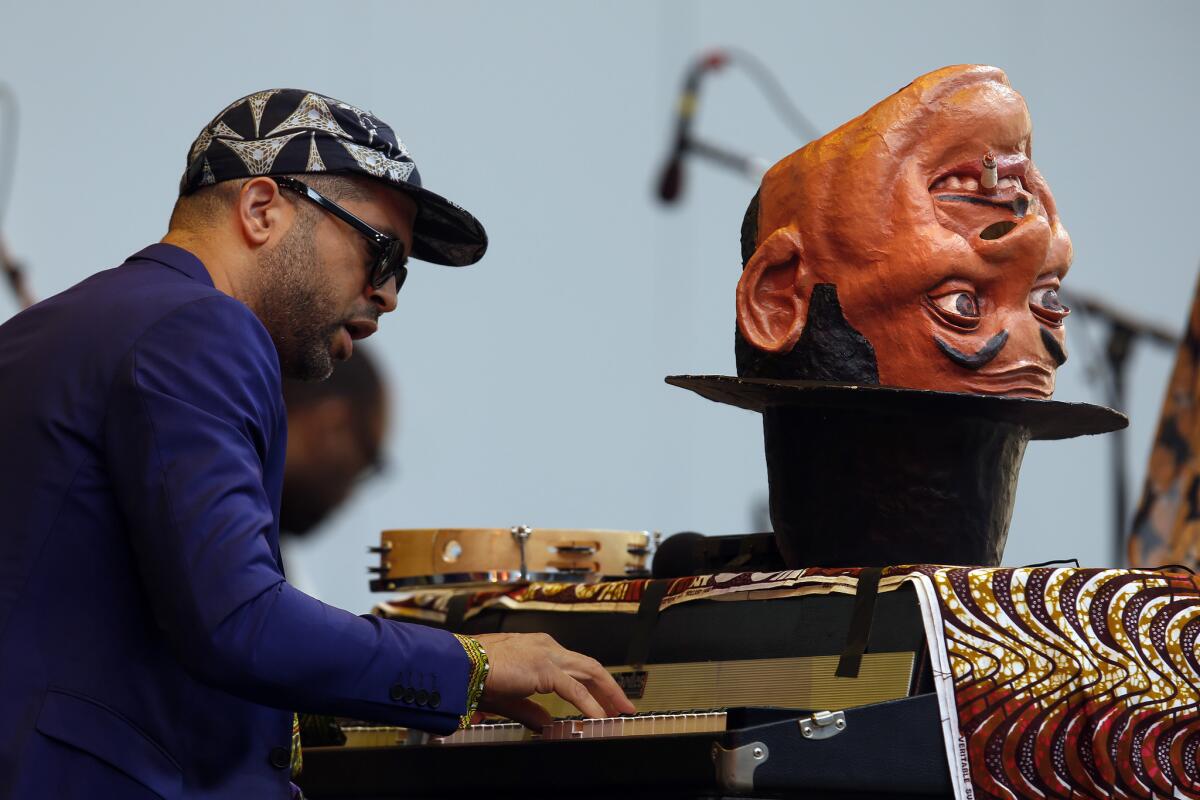Review: Playboy Jazz Festival keeps the party moving at the Bowl

Jason Moran — with custom-sculpted Fats Waller mask — onstage on Saturday.
- Share via
“We’d like to play a piece for Ornette Coleman,” Jason Moran told the Playboy Jazz Festival crowd late Saturday afternoon.
Moran was midway though a rambunctious set with his R&B-soaked tribute to Fats Waller, and the Hollywood Bowl crowd, perhaps a little distracted by the approaching dinner hour and occasional low-flying beach ball, didn’t respond to the mention of the groundbreaking saxophonist, who died Thursday at age 85. So Moran repeated himself -- and the proper ovation never came.
Undaunted, the pianist donned his cigarette-chomping Waller mask and swayed with a tambourine amid his band’s woozy deconstruction of Coleman’s “Lonely Woman,” translating the 1959 classic and its sighing melody into a percolating trance augmented by looping electronics and an insistent groove framed by Moran’s keyboards and Jeff Parker’s flinty guitar. The song masterfully bridged the gap between Coleman’s revolutionary early work and the idiosyncratic funk-rock of his group Prime Time, which played the festival in 1982.
It was the only time Coleman’s name came up during the festival’s first day.
That the death of a giant like Coleman wouldn’t ripple though a festival with “jazz” in its name felt like a shock, but Playboy isn’t like other jazz festivals. Neither offering an annual snapshot of the genre like the coastal pillars in Monterey or Newport, nor diverging into pop and rock for its biggest headliners at similar such gatherings around the country, Playboy is more of a celebration, a combination picnic and party designed to start the L.A. summer on a high note.
And, given that the festival’s first day was sold out, it’s hard to argue with its methods. The festival -- co-presented for the second year by the L.A. Philharmonic -- set aside its long-held fondness for the top-selling but sleepy smooth jazz side of the music for an event that remains committed to honoring its name.
Though he’s the creative chair for jazz at the L.A. Philharmonic, Herbie Hancock has often spoken of the festival’s challenges for performers to hold a 17,000-plus audience’s attention. Maybe that’s why neither he nor his longtime partner Wayne Shorter mentioned Coleman during their set, which included students from the Thelonious Monk Institute of Jazz at UCLA.
But Coleman’s unfettered voice could be heard in the odd-angled improvisations of young pianist Carmen Staaf, and an extended free-form duet between Hancock and Shorter, who chased each other through a web of electronics and improvisation that made room for the saxophonist to slyly reference the “Close Encounters” theme, which earned a ripple of cheers. Their far-reaching ventures didn’t always hold together, but they certainly didn’t stand still either.
Less fortunate in fighting distraction was Chilean-born saxophonist Melissa Aldana, a rising star who performed as the sun was at hottest after an opening set from the Los Angeles County High School for the Arts Vocal Jazz Ensemble. Last year’s winner of the Monk Institute’s saxophone competition, Aldana had a twisting, soft-handed tone; her nimble trio deserved better than a crowd still finding its seats.
Guitar group the Campbell Brothers paid tribute to one of the most sacred works of jazz in John Coltrane’s “A Love Supreme” by feeding it through the lens of Sacred Steel, a Pentecostal tradition of substituting steel guitars in place of a church organ that’s been around since the ‘30s. The connection between Coltrane’s work of spiritual exploration merged beautifully with the Campbells’ gospel-fueled runs for a set that burned with a surging intensity, peaking with an exultant, double-time run through “Pursuance” that turned the whole Bowl into believers.
Moran’s inside-out tribute to one of jazz’s earliest stars captivated from the start with the surging Afrobeat of Babatunde Olatunji’s “Jin-Go-Ba-La” (popularized by Santana), and reconstructed takes on Waller’s classics such as “Honeysuckle Rose” and “Ain’t Misbehaving,” led by vocalist Lisa Harris. Setting aside his oversize mask of Waller’s grinning head, Moran broke into a standout duet with drummer Charles Haynes that combined a flickering, delicate beauty with a sledgehammer-swung dissonance that eventually locked into a rollicking groove that evoked the cut-and-paste compositions of hip-hop as the song rebuilt around him.
R&B hitmaker Aloe Blacc carved out room between irresistible hits “I Need a Dollar” and “Wake Me Up” to pay respect to Michael Jackson with a bluesy recast of “Billie Jean” that kept the glowing bunny ear merchandise bobbing through the crowd at night. Later, bandleader Eddie Palmieri invoked the late Cal Tjader before his band surged into a piece marked by a zigzagging runs from guest vibraphonist Joe Locke.
But maybe the festival’s most indelible nod to history came with the appearance of the Gerald Wilson Orchestra. Wilson, a brilliant composer and educator who essentially embodied Los Angeles jazz history until his death last year at age 96, was brought to life in a set conducted by his son, guitarist Anthony Wilson.
With “Triple Chase,” the orchestra offered a fiery opening statement marked by an early solo from saxophonist Kamasi Washington, who joined Gerald Wilson’s band years ago when he was still a student at UCLA. Now 34, Washington has been one of the most talked about jazz artists of 2015 with his three-disc new album “The Epic,” but here he was again part of Wilson’s expertly tuned machine, which surged through the late bandleader’s indelible songbook, including “Blues for Yna Yna,” “Perdido” and “Viva Tirado,” which was marked by a lovely turn on violin by Yvette Devereaux.
As the sun fell on the Bowl, Wilson seemed at a loss for words in expressing gratitude for bringing his father’s compositions and arrangements to the festival. With multiple generations coming together to keep the music moving forward, not much more needed to be said.
Want to read more but in 140-character bursts? Follow me @chrisbarton.
More to Read
The biggest entertainment stories
Get our big stories about Hollywood, film, television, music, arts, culture and more right in your inbox as soon as they publish.
You may occasionally receive promotional content from the Los Angeles Times.











